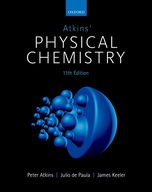?Before attempting these calculations, see P7E.1. Now consider the case where in the
Chapter 7, Problem P7E.2(choose chapter or problem)
Before attempting these calculations, see Problem P7E.1. Now consider the case where in the diatomic molecule A–B the mass of B is much greater than that of A. (a) Show that for an isotopic substitution of A, the ratio of vibrational frequencies is \(\omega_{\mathrm{A}^{\prime} \mathrm{B}} \approx \omega_{\mathrm{AB}}\left(m_{\mathrm{A}} / m_{\mathrm{A}^{\prime}}\right)^{1 / 2}\). (b) Use this expression to calculate the vibrational frequency of \({ }^{2} \mathrm{H}^{35} \mathrm{Cl}\) (the vibrational frequency of \({ }^{1} \mathrm{H}^{35} \mathrm{Cl} \text { is } 5.63 \times 10^{14} \mathrm{s}^{-1}\)). (c) Compare your answer with the value obtained in the previous Problem P7E.1. (d) In organic molecules it is commonly observed that the C–H stretching frequency is reduced by a factor of around 0.7 when \({ }^{1} \mathrm{H}\) is substituted by \({ }^{2} \mathrm{H}\): rationalize this observation.
Text Transcription:
ω_A^′B ω_AB m_A m_A^ω^½
^2 H^35Cl
^1 H^35Cl is 5.63 × 10^14 s^−1
^1H
^2H
Unfortunately, we don't have that question answered yet. But you can get it answered in just 5 hours by Logging in or Becoming a subscriber.
Becoming a subscriber
Or look for another answer
